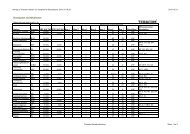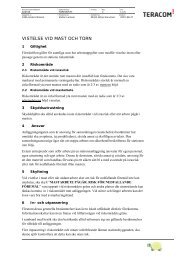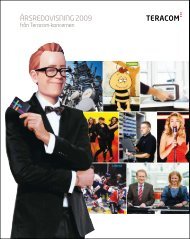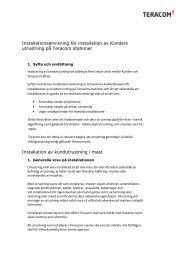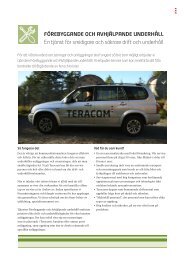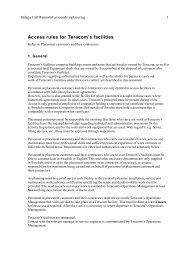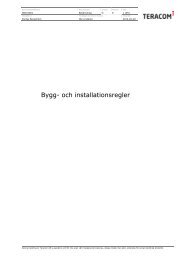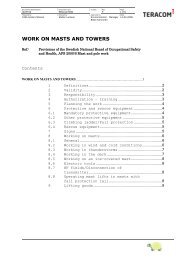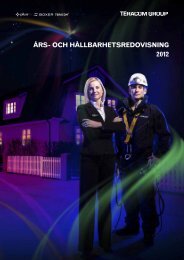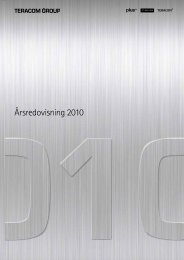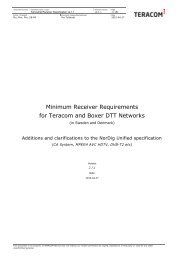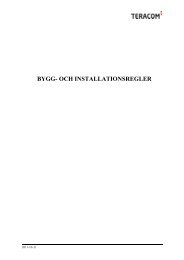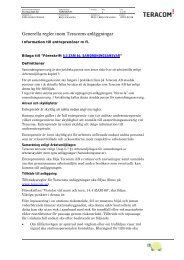Annual and Sustainability Report 2011 - Teracom
Annual and Sustainability Report 2011 - Teracom
Annual and Sustainability Report 2011 - Teracom
You also want an ePaper? Increase the reach of your titles
YUMPU automatically turns print PDFs into web optimized ePapers that Google loves.
An integrated TV business<br />
The Group's strategy <strong>and</strong> planning assume that the TV business<br />
is a completely integrated business - from the broadcast<br />
station via the boxes out to the viewer, a viewer who is preferably<br />
a Pay-TV customer. This integrated business will be run<br />
in a similar way in market after market <strong>and</strong> the reason is, of<br />
course, that competition is growing <strong>and</strong> terrestrial networks<br />
must therefore be developed. There are three reasons why<br />
network <strong>and</strong> Pay-TV should sit together <strong>and</strong> exp<strong>and</strong> into<br />
more markets:<br />
1. Development of services <strong>and</strong> technologies requires<br />
consensus <strong>and</strong> careful commercial coordination.<br />
2. The various TV markets share many similarities <strong>and</strong> the<br />
terrestrial networks function in much the same way,<br />
so investments <strong>and</strong> lessons learned from one market<br />
become far more valuable if they can be applied in other<br />
markets.<br />
3. A large general customer base is essential to achieve<br />
sufficient bargaining power against suppliers <strong>and</strong> broadcasters.<br />
The Swedish market is the most mature in the <strong>Teracom</strong><br />
Group <strong>and</strong> services developed – HDTV, broadb<strong>and</strong>, IP telephony<br />
<strong>and</strong> set top boxes for Video On Dem<strong>and</strong> – will obviously<br />
be launched in other markets. It is important to take<br />
advantage of economies of scale in order to strengthen the<br />
competitiveness of the terrestrial networks in a financially<br />
sound way.<br />
The terrestrial networks in which network <strong>and</strong> Pay-TV are<br />
integrated will become more competitive, at least in small<br />
countries with several competing means of distribution <strong>and</strong><br />
where advertising is not enough to finance the many free<br />
TV channels. The <strong>Teracom</strong> Group currently has an integrated<br />
business in both Sweden <strong>and</strong> Denmark, <strong>and</strong> the Group's aim<br />
is to achieve full integration in all markets.<br />
Strength in a dedicated broadcast platform<br />
The terrestrial networks offer great opportunities for development<br />
<strong>and</strong> there is a considerable need to strengthen the<br />
platform on both the network <strong>and</strong> service sides. In 2010<br />
HDTV was launched in the Swedish network using the new<br />
broadcasting st<strong>and</strong>ard DVB-T2, which radically optimizes<br />
frequency utilization. This technology makes it possible over<br />
time to completely switch to HDTV, which is becoming the<br />
image st<strong>and</strong>ard for all TV sets. The reason of course is that<br />
broadcast TV is competing with online video <strong>and</strong> image<br />
quality is one of the great advantages of a dedicated broadcast<br />
platform. DVB-T2 can also be used for many more channels,<br />
or a mix of HDTV <strong>and</strong> new channels.<br />
TV-like services can be accessed in an increasing number<br />
of ways. Movies can be rented via broadb<strong>and</strong>, broadcasters<br />
offer on dem<strong>and</strong> services that can be watched both live or<br />
stored, while YouTube <strong>and</strong> similar sites offer an abundance of<br />
videos from all over the world, many of them from television.<br />
Boxer's new On Dem<strong>and</strong> service is also based on delivery via<br />
the customer's own broadb<strong>and</strong> connection. All this underscores<br />
how traditional TV networks are challenged by more<br />
<strong>and</strong> more TV-like services over broadb<strong>and</strong>. The traditional TV<br />
networks, which broadcast in one direction, offer a number<br />
of advantages that may become crucial as online video use<br />
increases:<br />
• An infinite number of receivers can be reached in the<br />
area covered by the broadcasts. Number of users does<br />
not affect capacity, unlike broadb<strong>and</strong>, where each new<br />
user needs new capacity. This is crucial for live TV, an<br />
extremely capacity-intensive service for which people<br />
have little tolerance for delays.<br />
• The broadcast transmission is paid for by the broadcaster,<br />
which is either the program company or the Pay-TV operator.<br />
For the user, reception is free (of course customers<br />
buy a subscription for Pay-TV services). Households<br />
usually pay a fixed fee for broadb<strong>and</strong>. This model does<br />
not work as well if capacity requirements radically<br />
increase from various media. Just who will pay for broadb<strong>and</strong><br />
services that dem<strong>and</strong> more <strong>and</strong> more capacity is a<br />
major issue in the telecom world. Regardless of where<br />
the bill is sent, it has to be paid. This makes broadcast<br />
networks appear to be significantly more cost-efficient.<br />
• The new image st<strong>and</strong>ard will be HDTV, which requires<br />
much more capacity than st<strong>and</strong>ard TV <strong>and</strong> will pose<br />
major challenges for broadb<strong>and</strong> networks <strong>and</strong> business<br />
models.<br />
Pay-TV<br />
Services <strong>and</strong> technologies<br />
introduced in the Group<br />
Network<br />
TV<br />
RADIO<br />
TELECOM<br />
1995 Digital radio (DAB)<br />
1999 Digital TV with DVB-T/MPEG2<br />
2007 Boxer TV navigator<br />
2008 Digital TV with DVB-T/MPEG4<br />
2009 Broadb<strong>and</strong><br />
IP telephony<br />
DAB+<br />
2010 HDTV with DVB-T2/MPEG4<br />
Regional versions of national TV<br />
channels<br />
<strong>2011</strong> Video-on-dem<strong>and</strong><br />
The <strong>Teracom</strong> Group’s strategy is based on the premise that the TV business is a completely cohesive business.<br />
7



